Strategic cruise missile Northrop SM-62 Snark (USA)
The US program to develop strategic cruise missiles launched in the mid-forties. Having studied domestic and foreign missile technology projects, the US Army Air Force Command in August 1945 issued technical requirements for advanced weapons. It was necessary to develop a cruise missile with a flight speed of the order of 600 miles per hour (about 960 km / h) and a range of 5000 miles (8000 km) with the ability to carry warheads weighing 2 thousand pounds (about 900 kg). The next few months, the industry was engaged in the preliminary study of the project of such weapons.
In January, 1946, the company Northrop Aircraft presented a preliminary draft of a new cruise missile with different characteristics. Available technology allowed the rocket to be built at a subsonic speed and range of about 3000 miles (4800 km). Soon the military demanded to remake the project in accordance with the new requirements. Now it was necessary to develop two versions of cruise missiles with different characteristics. One should have a subsonic speed and range of 1500 miles (2400 km), the other should be made supersonic with a range of up to 5000 miles. The payload of both missiles was set at the level of 5000 pounds (about 2300 kg).
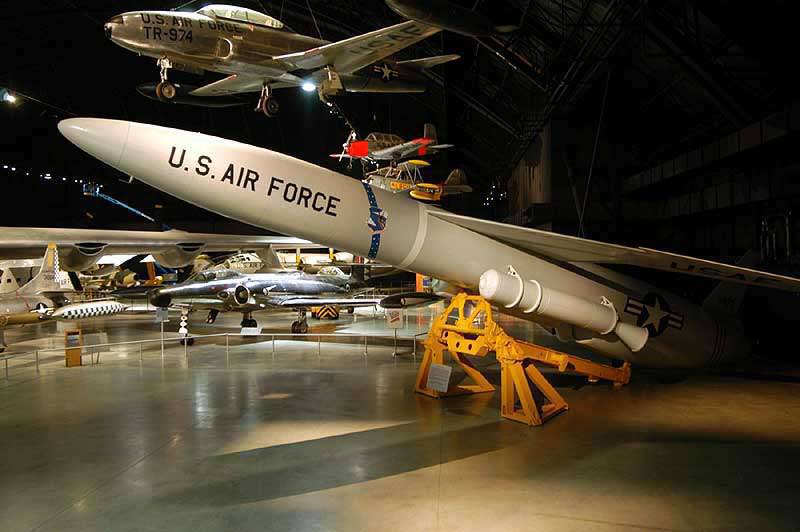
SM-62 Snark production rocket in the museum. Photo Rbase.new-factoria.ru
In accordance with the new order of the military, Northrop began working on two new projects. The subsonic rocket was called the MX-775A Snark, the supersonic MX-775B Boojum. Also in the early stages of the Snark project, the alternative designation SSM-A-3 was used. The names of the projects, “Snark” and “Bujum” were taken from Lewis Carroll’s “Snail Hunt”. According to this poem, snark was a mysterious creature living on a distant island. Bujum, in turn, was a particularly dangerous type of snark. For whatever reason, John Northrop chose such names for two new projects - is unknown. Nevertheless, the names justified themselves: the development of the Snark was no less difficult than the hunt for its literary namesake.
Preliminary work on two projects continued until the end of 1946, after which problems began. At the very end of the 46th, the military department decided to reduce costs, including by closing some new projects. The updated defense budget implied the closure of the MX-775A Snark project, but allowed the development of the MX-775B Boojum to continue. J. Northrop did not agree with this decision, because of which he was forced to start negotiations with the military command aviation. During lengthy negotiations, he managed to defend the Snark project, although this required a change in the technical proposal. Now it was proposed to bring the flight range of the MX-775A rocket to 5 thousand miles, and the cost of an individual rocket (with a series of 5 thousand units) was reduced to 80 thousand dollars. It was planned to complete the development of the project in two and a half years. According to the calculations of J. Northrop, more than half of the required efforts should have been made in the development of guidance systems.
The head of the aircraft building company managed to defend the project MX-775A. At the beginning of 1947, the military decided to resume its development. At the same time, the previous decision regarding the MX-775B project was revised. The project of the Bujum rocket, due to its great complexity, was transferred to the category of long-term research. These works gave the result much later, and already in the framework of the next project.

One of the earliest prototypes of the MX-775A in flight. Photo Designation-systems.net
Work on the project "Snark" continued, but the development of this rocket was associated with a lot of difficulties. To fulfill the stated requirements, the designers had to conduct a lot of new research and solve a large number of specific tasks. In addition, the project was faced with a lack of understanding or even opposition from some military leaders. In theory, an intercontinental cruise missile could really take off from the territory of the United States and deliver a nuclear warhead to the territory of a potential enemy. However, the first stages of the project clearly showed how difficult it is to create such a weapon, and how expensive it will be. In addition, the conservatism of command, which relied more on the usual bombers, had an effect. It is worth noting that the critics of the MX-775A and MX-775B projects were right on some issues, which was later confirmed in practice.
Misunderstanding of some military leaders in the future several times led to a change in plans. Thus, in 1947, the schedule was approved, according to which the 10 should have been launched for test launches of the new rocket. The first launch was scheduled for Spring 1949 of the year. Due to the complexity of the project, the company-developer did not have time to start testing on time, which led to the intensification of opponents of the project. By pointing out the deadlines, in 1950, they were able to push the project down. This time, to the arguments about the dubious concept with ambiguous prospects, the facts of deadlines were added. Nevertheless, and this time J. Northrop and some representatives of the command were able to save the project "Snark" and continue its development.
In the meantime, the military has already compiled the proposed methodology for the use of non-existent weapons. It was planned that the MX-775A Snark cruise missiles will be used as a first-strike weapon, ensuring the continued operation of strategic nuclear forces. The purpose of the "Snarkov" were to be the radar and other air defense facilities of the Soviet Union. Thus, the first strike of cruise missiles was planned to "knock out" the air defenses, after which strategic bombers with nuclear bombs on board were to come into action. They were supposed to destroy the main objects of command, industry and troops.
The first flight of a promising cruise missile did not take place in the 1949 year, as the schedule required. However, by this time the company Northrop Grumman had already begun assembling the first prototype, which in the near future was to be tested. Interestingly, the prototype of the rocket had to differ markedly from the finished serial product. So, the first checks were supposed to be carried out using the N-25 project missiles. In the future, based on them, it was planned to create a new full-fledged combat missile.
The N-25 rocket was a typical projectile designed to engage ground targets. She received a cylindrical fuselage with a lively nose and tail fairing, swept wing and tail, consisting only of a large keel. The total length of this product was 15,8 m, wing span - 13,1 m. Take-off weight was determined at the level of 12,7 t. The Allison J33 turbojet engine was selected as the power plant. He was placed in the rear fuselage, next to the control equipment. The middle part of the rocket was given under the fuel tanks, and in the bow was placed a weight imitator of the warhead.
The N-25 prototype was supposed to be used to test the rocket's flight characteristics, which affected some of its features. It was equipped with a radio command control: it was supposed to fly a rocket from an airplane equipped with the necessary equipment. In addition, an experienced rocket was equipped with a retractable ski landing gear and a drag parachute for landing after test flights. She had to take off with a special launcher.
Initially, the first flight of the MX-775A rocket was planned for 1949 year, but these deadlines were thwarted. Due to the complexity of the project and the constant problems, the first prototypes of the N-25 were built only in 1950, and the first successful flight took place in April of 51 — two years after the originally specified time frame. Tests of a radio-controlled projectile on the basis of Holloman (units of New Mexico) showed the fundamental possibility of implementing existing plans, and also allowed to check the airframe and power plant.
16 N-25 products were built for testing. Until March 1952, the 21 test flight was completed. During these tests, radio-controlled rockets developed speeds up to M = 0,9 and were airborne up to 2 hours 46 minutes. Most of the tests ended in failure, which is why only five 52 missiles survived until the spring of the 16. One of the reasons for the many failures was the specific aerodynamics of the rocket, due to which the products flew with a high pitch angle, literally holding up the nose.
Further use of the N-25 product or its use as a basis for combat work was not possible. Back in the middle of 1950, the Air Force updated the requirements for a promising rocket, which required serious reworking of the project. The military demanded to increase the payload weight up to 3200 kg, to provide the possibility of a short-term supersonic throw to break through the enemy’s air defense, and also to increase the targeting accuracy. KVO at the maximum range should not exceed 500 m.
To fulfill the updated requirements, we had to start developing a new project, which received the corporate designation N-69A Super Snark. This rocket as a whole was based on existing developments, however, it differed from the N-25 in its large size, new engine and other units. The streamlined fuselage, which contained all the necessary equipment, was preserved, and the high-position swept wing was used again. The tail without a stabilizer has survived. Management of roll and pitch is now carried out with the help of controlled planes of the wing.
The airframe design was quite successful and met all the requirements. With some modifications of these or those units, it was later used in new modifications of the Super Snark. The total length of the rocket was 20,5 m, the wingspan was reduced to 12,9 m. The launch weight of the N-69A product was set at 22,2 t.
Due to the increase in size and weight of the structure, a new engine was needed. The updated rocket was equipped with Allison J71 turbojet engine. His task was to accelerate the rocket to speeds of the order of 800-900 km / h with the possibility of a short-term "jerk" at supersonic speeds. For the initial acceleration during takeoff, it was proposed to use two solid-fuel accelerators.
The proposal to use accelerators led to the need for additional tests. In the middle of 1952, Northrop Aircraft built three weight models of the N-69A rocket, which were used in throwing trials. In November of the same year, tests of the second accelerator version began. Before spring 53, four launches of modified N-25 missiles were performed, in which two accelerators were used each with thous. Pounds 47 (about 21,3 tons). According to the test results, twin accelerators with a load of 130 thousand pounds (59 tons) each, working 4 s were selected for use with a combat missile. This was enough to lift the rocket and pre-accelerate before turning on the main engine.
By the time the tests began, the MX-775A project again faced administrative problems. The command demanded that the tests be transferred from the Holloman base to the Patrick air base (pieces Florida). The construction of new facilities required for missile inspections took a lot of time, which is why in the next few years the tests were carried out in the old place.
By the mid-fifties, Northrop specialists developed a new version of the Super Snark project, differing from the basic equipment and some other features. This version of the rocket received the working designation N-69B. In the 1954-55, several new test launches were carried out. Regular inspections and improvements have allowed to improve the design, but completely eliminate all the shortcomings failed. However, already in 1955, the Snark project was able to be brought to full-scale tests with an attack of training objectives. However, in this case, not all launches were successful.
In May 1955, an event occurred that later led to the appearance of a new modification of the rocket. Another experienced rocket successfully reached the target area, but could not hit it, falling at a considerable distance from it. In connection with this failure, a new proposal appeared concerning the method of applying the combat load. Now it was necessary to make the warhead detachable. Going into the area of the target, the rocket had to drop a nuclear warhead, after which he was to fall on the target along a ballistic trajectory. The remaining rocket units should be undermined, creating a mass of false targets that impede the interception of the combat unit. This method of using weapons, according to calculations, allowed the combat unit to be dropped from a distance of about 80 km from the target.
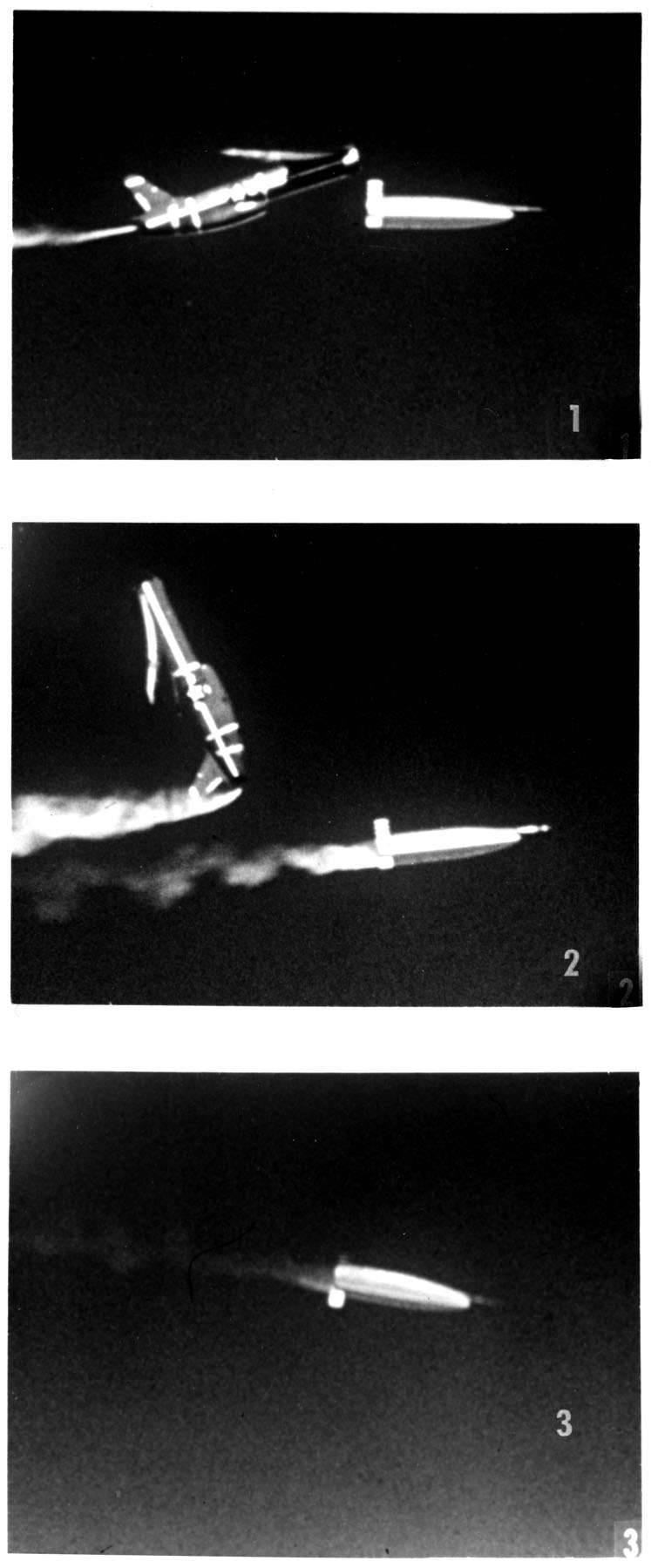
Branch of the warhead in flight. Photo of Wikimedia Commons
An updated project with the designation N-69C was developed by the fall of 1955. On September 26, the first launch of such a rocket took place. In November, another new modification was created - N-69D. It was a modified version of the "C" rocket powered by a Pratt & Whitney J57 engine. The use of such an engine made it possible to reduce fuel consumption, due to which the calculated flight range reached the required values. In addition, the N-69D rocket was supposed to carry drop outboard fuel tanks.
In this case, the most important innovation of the project “D” was the astro-inertial guidance system, which allowed the rocket to independently reach the target. The development of such systems started in the late forties, but the first experiments using astro-inertial navigation in flying laboratories were carried out only in the early fifties. By the middle of the decade, a system was created suitable for installation on a cruise missile.
In theory, inertial navigation with astrocorrection allowed to increase the accuracy of following the specified course, but in practice it was much more difficult. Problems with the power plant or airframe were almost solved, but there were problems with the guidance systems, which again led to accidents. Perhaps the most famous and interesting unsuccessful launch of the N-69D rocket took place in December 1956. The rocket took off from the Florida base and headed to the designated area of the Atlantic Ocean. During the flight, testers lost contact with the launched rocket, which is why the tests were considered unsuccessful. Lost rocket found only in 1982 year. Because of problems with the navigation system, she reached Brazil's airspace and fell in the jungle.
In June, the 1957 of the year began the testing of a new version of the rocket, the N-69E. Cruise missiles of this version were actually pre-production items. By the time this snark appeared, the main design issues were worked out, and most of the deficiencies were eliminated. At the same time, however, far from all the flaws were corrected. There were a lot of problems, and besides, the characteristics of the finished product still left much to be desired. Due to the impossibility of fulfilling the initial requirements, the terms of reference for the MX-775A project were adjusted several times. The same thing happened before the creation of the N-69E rocket. The next version of the requirements was different from the first number of parameters. In particular, it was planned to further increase the range, but the accuracy requirements were again relaxed.
The latest winged strategic cruise missile had a length of 20,5 m and a wing span of 12,9 m. The take-off weight was 21,85 t, two launch accelerators weighed another 5,65 t. The practical ceiling was set at the level of 57 km, the maximum range reached 46,7 km. The rocket received an astro-inertial navigation system, which made it possible to hit targets at a maximum range from the KVO 1050 km. Provided detachable warhead type W15,3 with a thermonuclear charge power 10200 megatons.
In parallel with the construction and testing of the N-69E missiles, the Pentagon’s leadership and industry tried to determine the future of the promising missile. It had a number of characteristic advantages over the existing means of delivering nuclear weapons, but it was not devoid of characteristic minuses. The Snark missile had a long range, which allowed it to perform its tasks, and an acceptable accuracy of hitting the specified target. In terms of speed, the rocket hardly differed from the existing bombers. In addition, supporters of the project pressed against the economic features of the project. Despite the complexity and high cost, the Snark was about 20 times cheaper than the latest Boeing bombers.
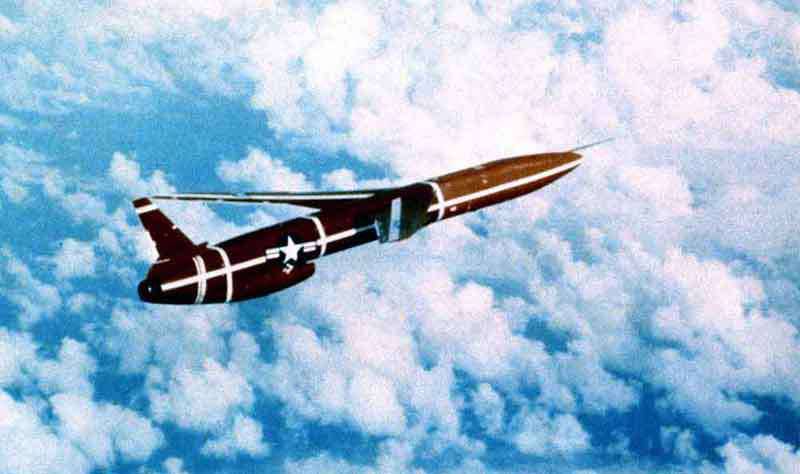
Rocket Snark in flight. Photo of Wikimedia Commons
In 1958, the new missile was adopted under the designation SM-62. Over the next few years it was supposed to form several formations armed with such missiles. Nevertheless, numerous difficulties led to the fact that in the end only one rocket wing was put on duty. The first serial missiles were handed over to troops at the very beginning of 1958 of the year. They were armed with 702-e strategic missile wing (Presque Isle base, pc. Maine). Soon the compound made several training launches.
Training launches of missiles, as in the case of the tests, were made in the direction of the Atlantic Ocean. Not all launches carried out by the calculations of the troops ended in a successful defeat of training targets. In most cases, the failure of certain nodes, because of what the rocket fell into the ocean. The coastal region of the Atlantic near the base was soon given the nickname “Snark infested waters” - “water teeming with snarks”. However, there have been successful launches. For the first time, the military was able to hit a training target in April 1959.
Soon, attempts began to deploy SM-62 Snark missiles at other bases, but because of the complexity of the work required and the need to build various objects, this work was not crowned with success. They simply did not have time to complete before the 1961 year, when the final decision was made about the future of the entire project.
Officially, the SM-62 missiles have been in service since 1958. However, this was not a full service with combat duty. The company-developer continued fine-tuning missiles, including by refining the already delivered products. At the same time, new launch complexes, command posts and other facilities were built. All these works were completed only by the end of 1960.
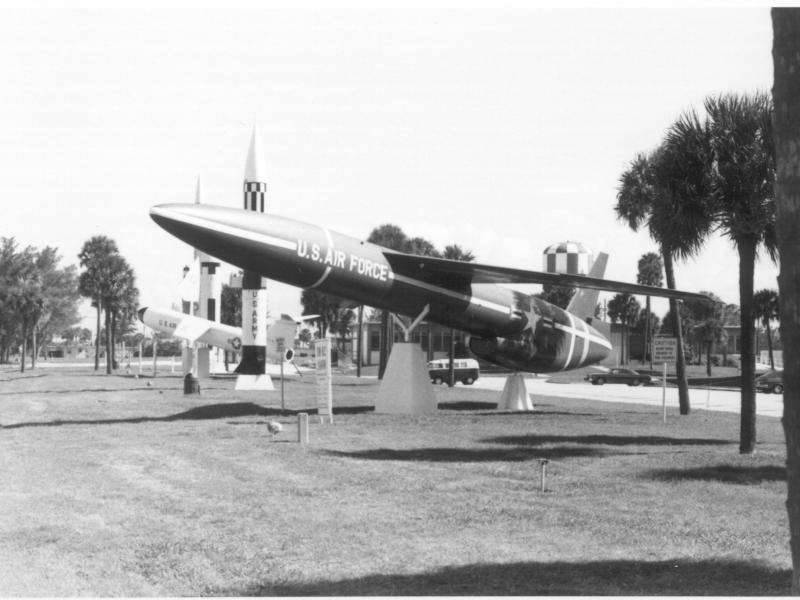
The serial rocket in the museum. Photo by Fas.org
Fully combat-ready 702-e wing recognized only in February 1961 year. By this time, 12 launchers had been built at the base of the compound, which had a single rocket in a state of constant readiness. In the case of an order, the base’s personnel should have launched an immediate launch of all the missiles aimed at objects of the Soviet Union. Due to the subsonic speed of the flight to the target, the rocket took several hours.
It should be recalled that from the very beginning of the work, the Snark project was criticized by commanders and politicians. First of all, the reason for the negative reviews was the dubious concept of a subsonic cruise missile with an intercontinental range and the low reliability of the finished products. In the future, a list of topics of criticism added new items. In addition, by the early sixties, the SM-62 cruise missiles were compared with the latest Titan ballistic missiles. At a similar cost, they were easier to operate, safer and more efficient. Also, the concept of an intercontinental ballistic missile made it possible to develop such a weapon with a significant increase in the basic characteristics.
At the beginning of 1961, the new US president was John F. Kennedy. The Kennedy Administration decided to carry out several important reforms, including in the field of armaments. Another analysis of the project Snark showed an unacceptably low ratio of the cost and effectiveness of this development. The consequence of this was the order of the country's leadership on the termination of all work on the project and the removal of missiles from armaments. At the end of March, 1961, J. Kennedy, in his speech, criticized the SM-62 missiles. In June of the same year, the Minister of Defense ordered the dismantling of the 702 strategic rocket wing and the removal of existing cruise missiles from service. Full service connection lasted less than four months. Part of the missiles in the army was disposed of, some products were transferred to several museums.
The MX-775A / N-25 / N-69 / SM-62 project was based on the ambiguous concept of a cruise missile with intercontinental range. The project proposed the creation of a projectile capable of taking off from the territory of the United States and hitting the target on the territory of the Soviet Union. Solving this problem with technologies of the level of the late fifties was extremely difficult, which led to the corresponding consequences. The designers of the company Northrop Aircraft faced a lot of various problems, the solution of which required a serious investment of time, effort and money. As a result, the design task was generally completed, but the reliability of the finished equipment left much to be desired.

Museum sample. Photo Designation-systems.net
The efforts of the engineers, J. Northrop and the military who supported the project, allowed the SM-62 to be brought to military service, but all the flaws were not corrected, which affected its further fate. The change of leadership of the country, as well as the emergence of new weapons put an end to stories project snark. In addition, this ended all attempts to adapt the ground-to-ground cruise missiles for use as strategic weapons. Later, other original ideas were proposed, however, the projects of “classic” strategic cruise missiles were not developed later.
It should be noted that the SM-62 project, despite its unsuccessful completion, led to the emergence of the only strategic intercontinental cruise missile that was able to reach operation in the military. In the fifties and sixties, several projects of similar weapons were created in the world at once, however, only the product "Snark" reached mass production and use in the troops. Other projects were closed at earlier stages, when the excessive complexity of creating such systems and the absence of real prospects in the light of the current development of rocket technology were revealed.
On the materials of the sites:
http://fas.org/
http://designation-systems.net/
http://strategic-air-command.com/
http://rbase.new-factoria.ru/

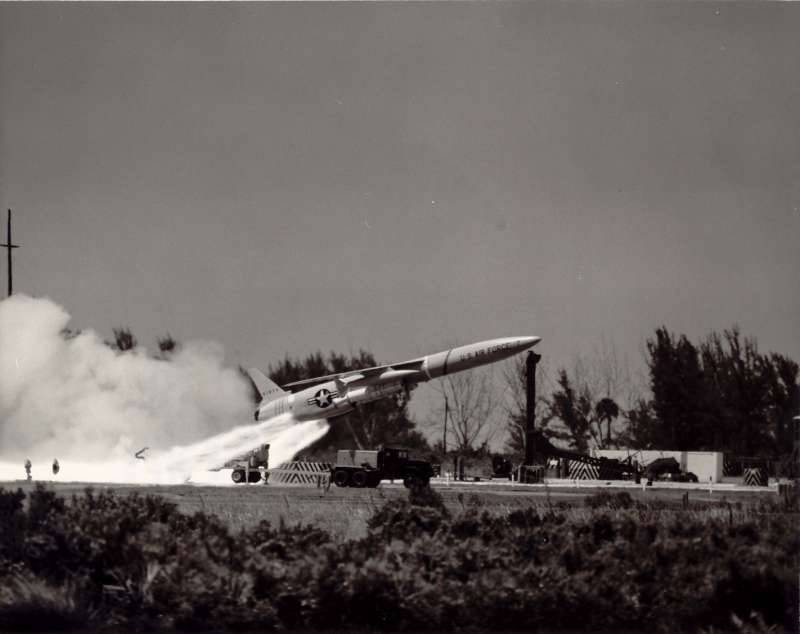
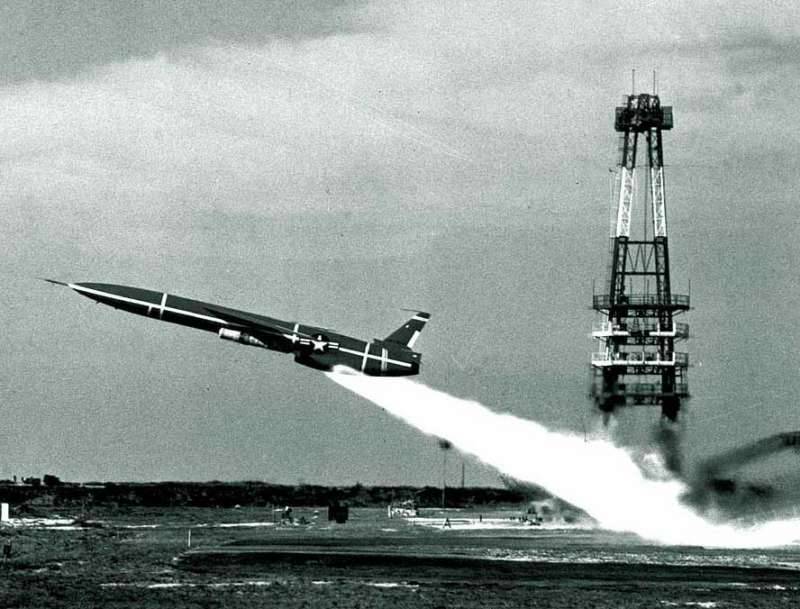
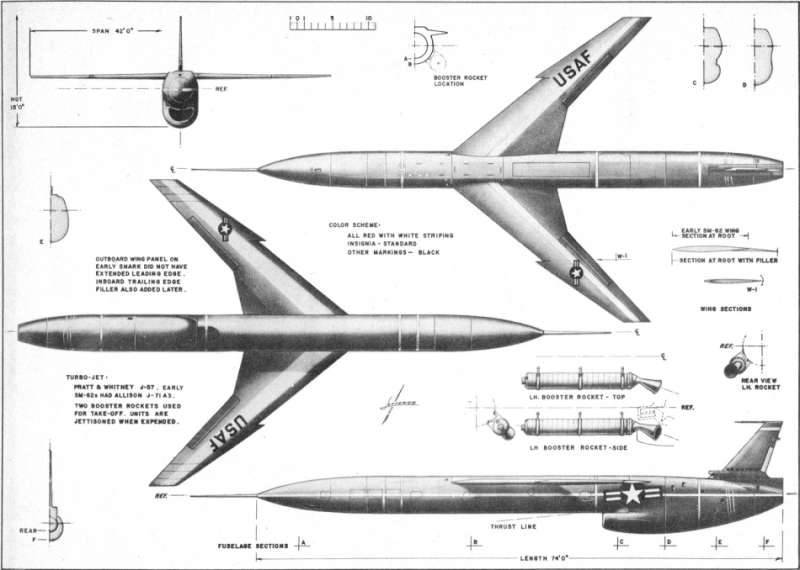
Information